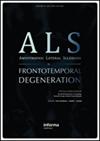爱丁堡认知和行为肌萎缩侧索硬化症筛查(ECAS):在希腊人群中区分ALS和阿尔茨海默病的敏感性
IF 2.8
4区 医学
Q2 CLINICAL NEUROLOGY
Amyotrophic Lateral Sclerosis and Frontotemporal Degeneration
Pub Date : 2019-08-30
DOI:10.1080/21678421.2019.1655059
引用次数: 3
摘要
【摘要】目的:(1)对ECAS进行希腊文改编,在ALS患者中进行验证,并与ALS- cbs进行比较。(2)对比ACE-III和mini-ACE,确定ECAS在区分AD与非痴呆性ALS患者中的敏感性和特异性。方法:招募ALS患者(n = 28), AD患者(n = 26)与ALS患者(n = 24)进行年龄、性别、文化程度匹配。标准数据来源于随机抽样的对照(n = 52)。采用贝叶斯相关分析检验收敛效度。采用贝叶斯t检验评估组间差异。采用受试者工作特征(ROC)曲线分析和曲线下面积(AUC)来评估区分AD与非痴呆性ALS患者的敏感性和特异性。结果:除行为访谈外,ECAS及其分项得分与ALS-CBS表现出稳健的相关性。语言障碍和语言流畅性是ALS患者最突出的缺陷。最常见的变化是冷漠。ROC分析表明,ECAS-ALS非特异性评分(包括记忆和视觉空间域)是区分AD和ALS患者最敏感和特异性的评分。其他方法的灵敏度较高,但特异性较差。结论:ECAS是一种多用途的筛查工具。ECAS-ALS特异性评估ALS中高度普遍的认知障碍的全谱。ECAS-ALS非特异性(记忆和视觉空间)评分是检测AD相关缺陷的敏感评分,能够比ACE-III和mini-ACE更好地区分AD与非痴呆性ALS患者。本文章由计算机程序翻译,如有差异,请以英文原文为准。
The Edinburgh cognitive and behavioral amyotrophic lateral sclerosis screen (ECAS): sensitivity in differentiating between ALS and Alzheimer’s disease in a Greek population
Abstract Objectives: (1) Adapt the ECAS into Greek, validate it in ALS patients and compare with the ALS-CBS. (2) Determine the sensitivity and specificity of ECAS in the differentiation between AD and non-demented ALS patients as compared with the ACE-III and mini-ACE. Methods: ALS patients (n = 28) were recruited and AD patients (n = 26) were matched in age, sex, and education with ALS patients (n = 24). The normative data were derived from a random sample of controls (n = 52). Bayes correlation analysis was conducted to examine convergent validity. Bayes t-test was performed to assess between groups’ differences. Receiver operating characteristics (ROC) curve analyses and area under the curve (AUC) were implemented to appraise the sensitivity and specificity in the differentiation between the AD and non-demented ALS patients. Results: The ECAS and its sub-scores in addition to the behavior interview demonstrated robust correlations with the ALS-CBS. Impairment in language and verbal fluency were the most prominent deficits in the ALS patients. The most frequently reported change was apathy. The ROC analysis demonstrated that the ECAS-ALS nonspecific score (comprising memory and visuospatial domains) is the most sensitive and specific in differentiating the AD from ALS patients. The other measures expressed high sensitivity, yet a poor specificity. Conclusions: The ECAS is a multi-purpose screening tool. The ECAS-ALS specific appraises the whole spectrum of the highly prevalent cognitive impairments in ALS. The ECAS-ALS nonspecific (memory and visuospatial) is a sensitive score to detect AD related deficits and is able to differentiate the AD from the non-demented ALS patients better than the ACE-III and mini-ACE.
求助全文
通过发布文献求助,成功后即可免费获取论文全文。
去求助
来源期刊

Amyotrophic Lateral Sclerosis and Frontotemporal Degeneration
CLINICAL NEUROLOGY-
CiteScore
5.40
自引率
10.70%
发文量
64
期刊介绍:
Amyotrophic Lateral Sclerosis and Frontotemporal Degeneration is an exciting new initiative. It represents a timely expansion of the journal Amyotrophic Lateral Sclerosis in response to the clinical, imaging pathological and genetic overlap between ALS and frontotemporal dementia. The expanded journal provides outstanding coverage of research in a wide range of issues related to motor neuron diseases, especially ALS (Lou Gehrig’s disease) and cognitive decline associated with frontotemporal degeneration. The journal also covers related disorders of the neuroaxis when relevant to these core conditions.
 求助内容:
求助内容: 应助结果提醒方式:
应助结果提醒方式:


